Scorpions have been around for over 400 million years. These arachnids have a distinctive appearance, with a pair of pincers and a long, curved tail ending in a venomous stinger. Scorpions can be found on every continent except Antarctica and are essential to many ecosystems. California has over 20 scorpion species, with some of the most unique and interesting species found nowhere else.
This article will focus on ten scorpions found in California, highlighting their habitat and sting frequency.
1. Arizona Bark Scorpion
Known as Centruroides sculpturatus, the Arizona bark scorpion is tiny and light brown. It can grow up to three inches long. It’s famous for its dangerous sting and is North America’s most venomous scorpion.
The Arizona bark scorpion has two small claws or pincers at the front of its body, followed by a long, segmented tail that curves upwards over its back.
The tail ends in a stinger that contains venom. Its light brown color helps it blend into its surroundings, making it difficult to spot.
Where Do They Live?
The Arizona bark scorpion lives in Mexico, the southwestern U.S., and California. It prefers arid habitats such as:
- Deserts
- Rocky areas
- Canyons
- Homes and other buildings
This scorpion is nocturnal and feeds on insects, spiders, and other scorpions.
How Often Do They Sting?
The frequency of stings has increased recently due to the expansion of human populations into areas where they live. For example, Arizona has 8,000 stings per year, most occurring during summer.
The sting can be extremely painful, especially for children and the elderly.
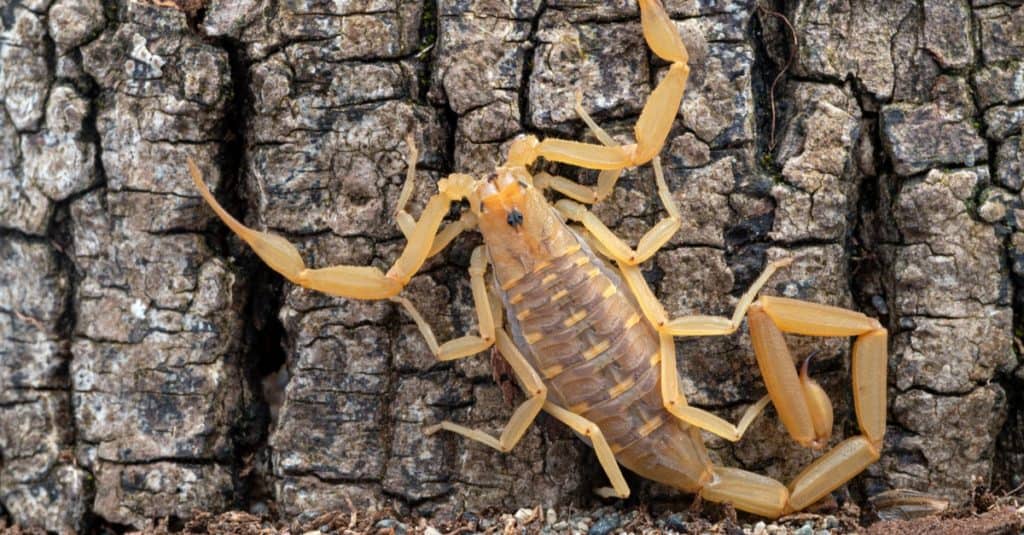
©Ernie Cooper/Shutterstock.com
2. Giant Desert Hairy Scorpion
Also known as Hadrurus arizonensis, it’s one of North America’s largest scorpions. It can grow up to 6 inches long.
This scorpion has a dark brown or black body with tan or yellowish hairs covering its legs and body.
It has two large pincers at the front of its body, followed by a long, thick tail that ends in a venomous stinger. Its size and hairy appearance make it a formidable predator.
Where Do They Live?
This scorpion thrives in the southwestern U.S. and northern Mexico, including California. It prefers arid habitats such as:
- Deserts
- Rocky areas
- Scrublands
Like most scorpions, it’s nocturnal and feeds on insects, spiders, and other scorpions. During the day, it hides in burrows or under rocks and logs to avoid the heat and emerges at night to hunt.
How Often Do They Sting?
The sting of the giant desert hairy scorpion isn’t as potent as that of the Arizona bark scorpion. But it can still be painful and cause swelling and redness at the sting site.
However, the frequency of stings is relatively low, as this scorpion tends to be shy and non-aggressive toward humans.
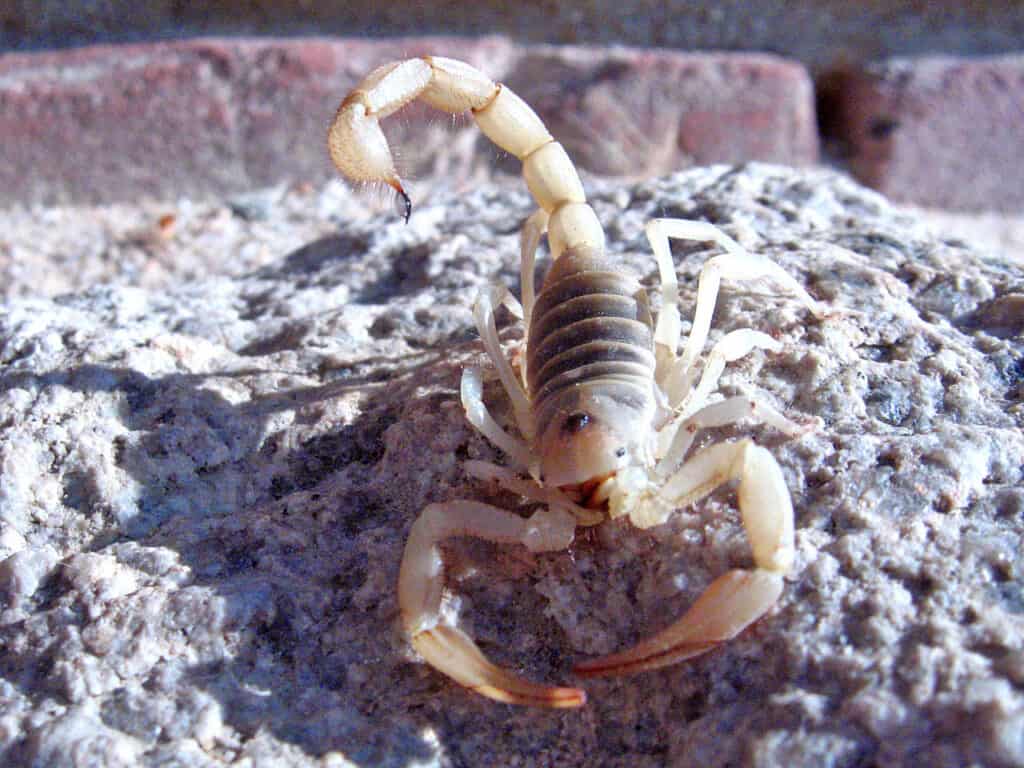
©Robb Hannawacker, while working for Joshua Tree National Park / CC BY 2.0 – License
3. California Forest Scorpion
The California forest scorpion (Uroctonus californicus) is a medium-sized scorpion that inhabits forested areas of California.
The California forest scorpion has a dark brown or black body with reddish-brown legs. It has two large pincers at the front of its body, followed by a long, slender tail that ends in a venomous stinger.
It can grow up to 3 inches long and has a flattened body shape that allows it to crawl into tight spaces.
Where Do They Live?
The California forest scorpion prefers forested areas of California, typically in higher elevations and moist environments such as:
- Leaf litter
- Logs
- Other debris
Like most scorpions, it’s nocturnal and feeds on insects, spiders, and other small animals.
How Often Do They Sting?
The California forest scorpion isn’t aggressive and only stings if it feels threatened. But if provoked, the sting can be painful and cause localized swelling and redness.
Luckily, the frequency of stings is relatively low, and most encounters with this species are harmless.
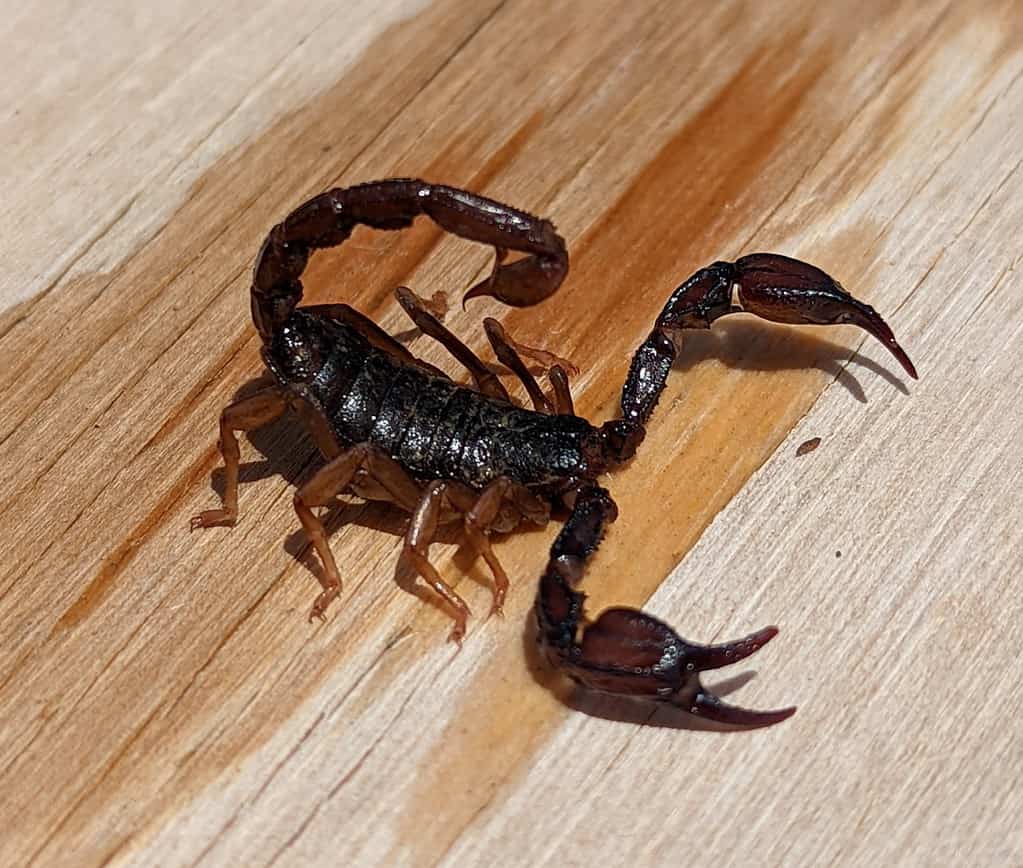
©loganjlbradley, CC BY 4.0 <https://ift.tt/yMOX13H>, via Wikimedia Commons – License
4. Striped-Tail Scorpion
The striped-tail scorpion (Hoffmannius spinigerus) is a small to medium-sized scorpion found in arid regions of California.
The striped-tail scorpion has a yellowish-brown body with two dark stripes running along the length of its tail. It has two large pincers at the front of its body, followed by a long, slender tail that ends in a venomous stinger.
It can grow up to 3 inches long and has a slender body shape that allows it to crawl into tight spaces.
Where Do They Live?
The striped-tail scorpion is common in California’s arid regions and in sandy or rocky areas. It prefers dry environments such as:
- Deserts
- Scrublands
- Grasslands
Like most scorpions, it’s nocturnal and feeds on insects, spiders, and other small animals.
How Often Do They Sting?
The striped-tail scorpion isn’t aggressive and only stings if it feels threatened or provoked. While the sting can be painful, it’s relatively mild and usually only causes localized swelling and redness.
The frequency of stings is relatively low, and encounters with this species are generally harmless.
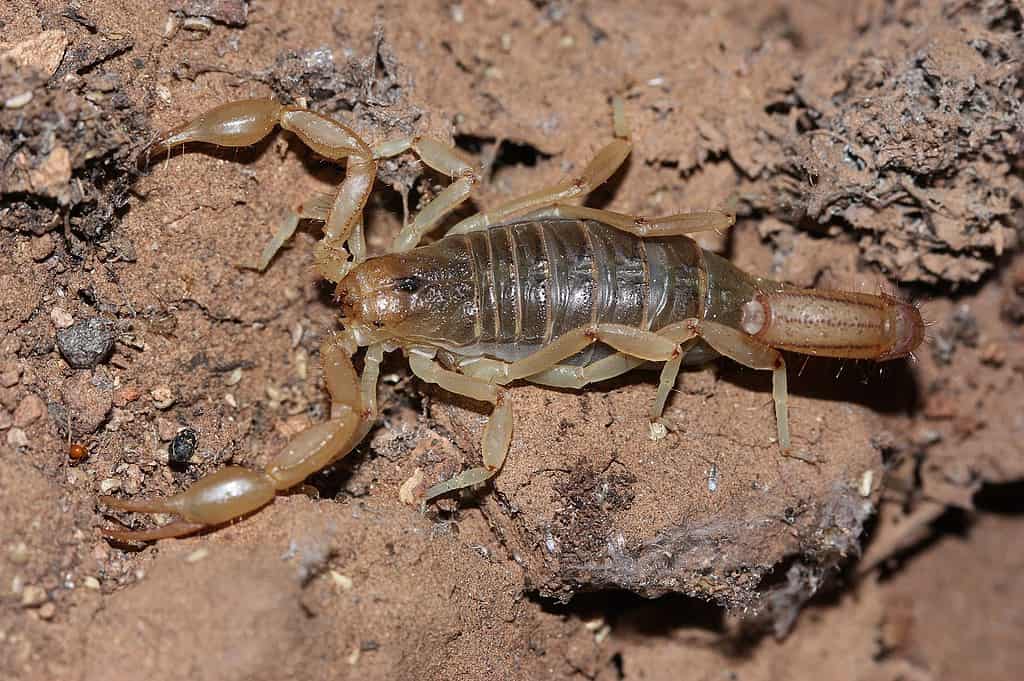
©Andrew Meeds, CC BY 4.0 <https://ift.tt/yMOX13H>, via Wikimedia Commons – License
5. California Common Scorpion
The California common scorpion (Paruroctonus silvestrii) is a scorpion species found throughout California and other parts of the western U.S.
They’re one of the most common scorpion species living in California. In fact, they are often encountered by hikers and campers.
The California common scorpion is around 2-3 inches long and has a slender body shape that helps it navigate through narrow spaces.
They have long, thin pincers and a thin tail with a stinger. Their body coloration can vary from light brown to reddish-brown.
Where Do They Live?
California common scorpions thrive in various habitats, including:
- Deserts
- Chaparral
- Woodland areas
They’re nocturnal and hide under rocks or burrows during the day to avoid the heat. At night, they come out to hunt for small insects and other arthropods.
How Often Do They Sting?
The frequency of stings by California common scorpions varies depending on several factors, such as:
- The scorpion’s size
- Age
- The level of threat they perceive
Generally, they don’t sting unless they feel threatened or provoked.

©Marshal Hedin from San Diego, CC BY-SA 2.0 <https://ift.tt/habxJH3>, via Wikimedia Commons – License
6. Yellow Ground Scorpion
The yellow ground scorpion (Vaejovis confusus) is a small scorpion species commonly found in California, particularly in the state’s southern regions.
They typically range from 1-2 inches long and are light yellow or tan.
Yellow ground scorpions have eight legs, two large claws, and a long, segmented tail that ends in a venomous stinger.
They have two and several smaller eyes on the top of their cephalothorax.
Where Do They Live?
Yellow ground scorpions are typically found in dry, sandy areas like deserts or coastal scrublands.
They’re nocturnal and typically hide under rocks or crevices during the day to avoid the heat. At night, they come out to hunt for small insects and other arthropods.
How Often Do They Sting?
Yellow ground scorpions aren’t considered aggressive and usually only sting in self-defense or if they feel threatened.
Their venom is generally considered mild and not life-threatening to humans, although it can cause pain and discomfort.

©Protasov AN/Shutterstock.com
7. Northern Scorpion
The Northern scorpion (Paruroctonus boreus) is a relatively large scorpion species found throughout California and other parts of the western U.S. and Canada.
They’re typically 2-3 inches long and are brown or reddish-brown.
Northern scorpions have eight legs, two large claws, and a long, segmented tail that ends in a venomous stinger.
They have two and several smaller eyes on the top of their cephalothorax. Northern scorpions are larger than many other scorpion species found in California.
Where Do They Live?
Northern scorpions are typically found in various habitats, including:
- Deserts
- Grasslands
- Forests
They’re nocturnal and hide under rocks or crevices during the day to avoid the heat. At night, they come out to hunt for small insects and other arthropods.
How Often Do They Sting?
Northern scorpions can sting when threatened or provoked. But they’re generally not aggressive towards humans and only sting in self-defense.
The frequency of Northern scorpion stings can vary depending on various factors, such as:
- The population density of scorpions in a particular area
- The amount of human activity in the scorpion’s habitat
- The level of interaction between humans and scorpions
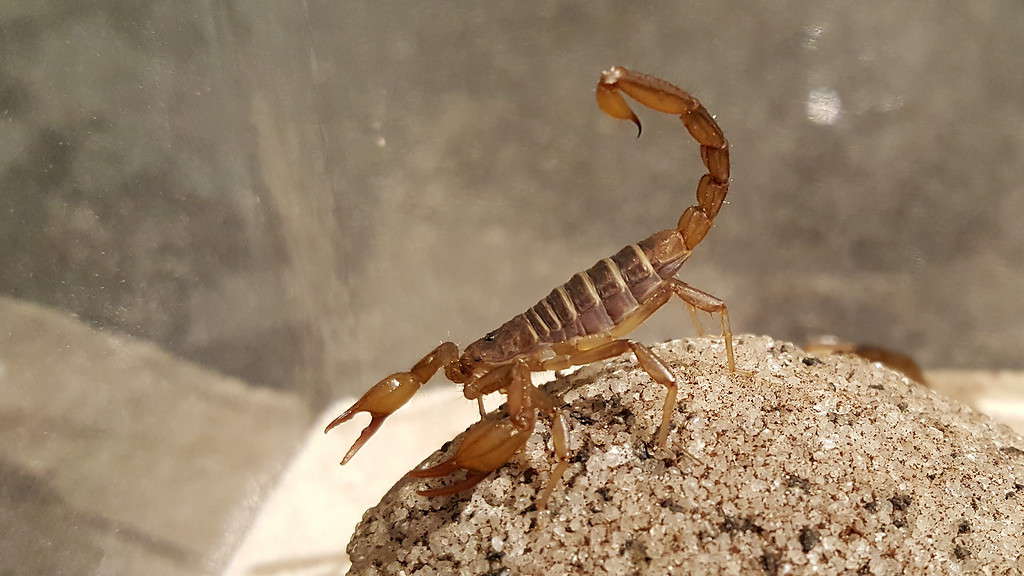
©Xbuzzi, CC BY-SA 4.0 <https://ift.tt/dvczhnx>, via Wikimedia Commons – License
8. Southern Devil Scorpion
Known scientifically as Vaejovis carolinianus, the Southern devil scorpion is a small scorpion species found in California and other parts of the southern U.S.
They typically range from 1-2 inches long and are brown or reddish-brown.
Southern devil scorpions have eight legs, two large claws, and a long, segmented tail that ends in a venomous stinger. In addition, they have two and several smaller eyes on the top of their cephalothorax.
Southern devil scorpions are one of the smallest scorpion species living in California.
Where Do They Live?
Southern devil scorpions are typically found in various habitats, including:
- Deserts
- Grasslands
- Forests
They’re nocturnal and typically hide under rocks or crevices during the day to avoid the heat. At night, they come out to hunt for small insects and other arthropods.
How Often Do They Sting?
The Southern devil scorpion’s sting frequency, or how often it stings, can vary depending on the individual scorpion and its circumstances, such as whether it feels threatened or provoked.
Generally, they aren’t considered highly aggressive and typically only sting as a last resort when threatened or cornered.
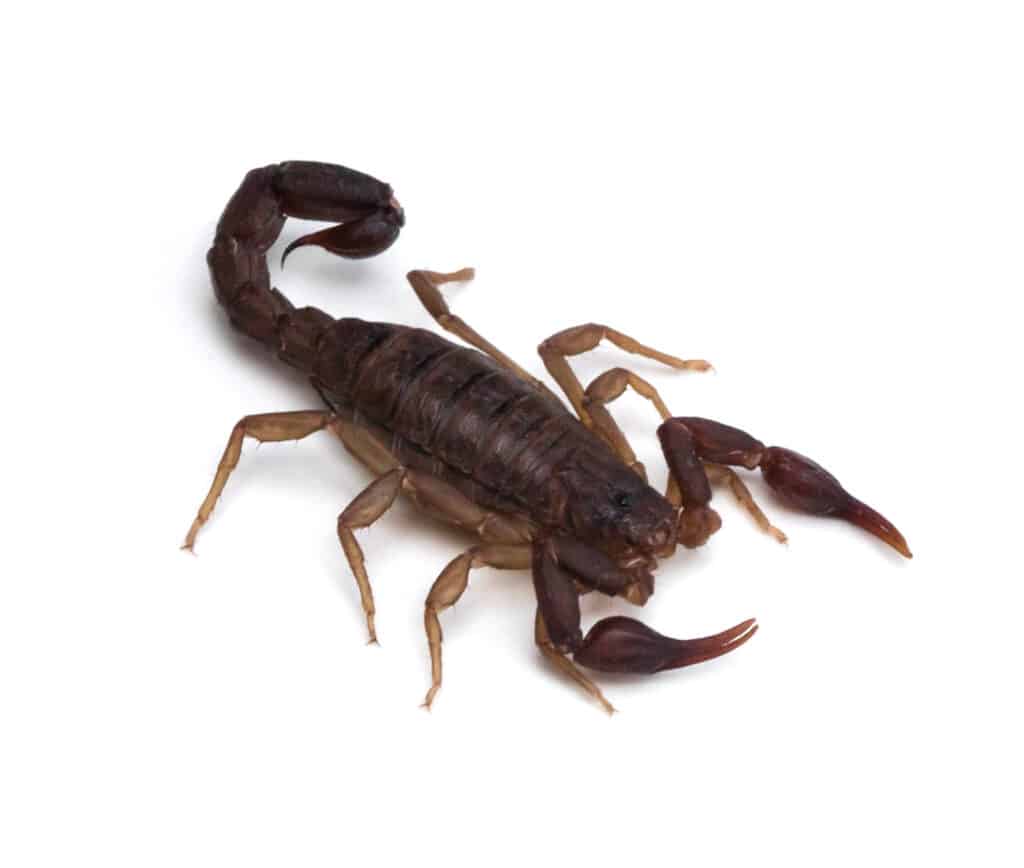
©iStock.com/epantha
9. Black Scorpion
The black scorpion (Hadrurus spadix) is a large scorpion species inhabiting California and other parts of the southwestern U.S. and northern Mexico.
They can range from 4-6 inches long, typically black or dark brown.
Black scorpions have eight legs, two large claws, and a long, segmented tail that ends in a venomous stinger. In addition, they have two and several smaller eyes on the top of their cephalothorax.
Black scorpions are larger than many other scorpion species found in California.
Where Do They Live?
Black scorpions are typically found in arid desert regions like the Mojave and Sonoran deserts.
They’re nocturnal and typically hide under rocks or burrows during the day to avoid the heat. At night, they come out to hunt for small insects and other arthropods.
How Often Do They Sting?
Black scorpions generally try to avoid humans and only sting in self-defense when threatened or provoked.
Therefore, it’s difficult to provide a specific frequency for black scorpion stings, as it can vary widely depending on many factors, such as:
- The location
- Population density
- Environmental conditions
Some areas may have a higher frequency of scorpion stings than others, particularly in regions where scorpions are more abundant or where human populations frequently come into contact with them.
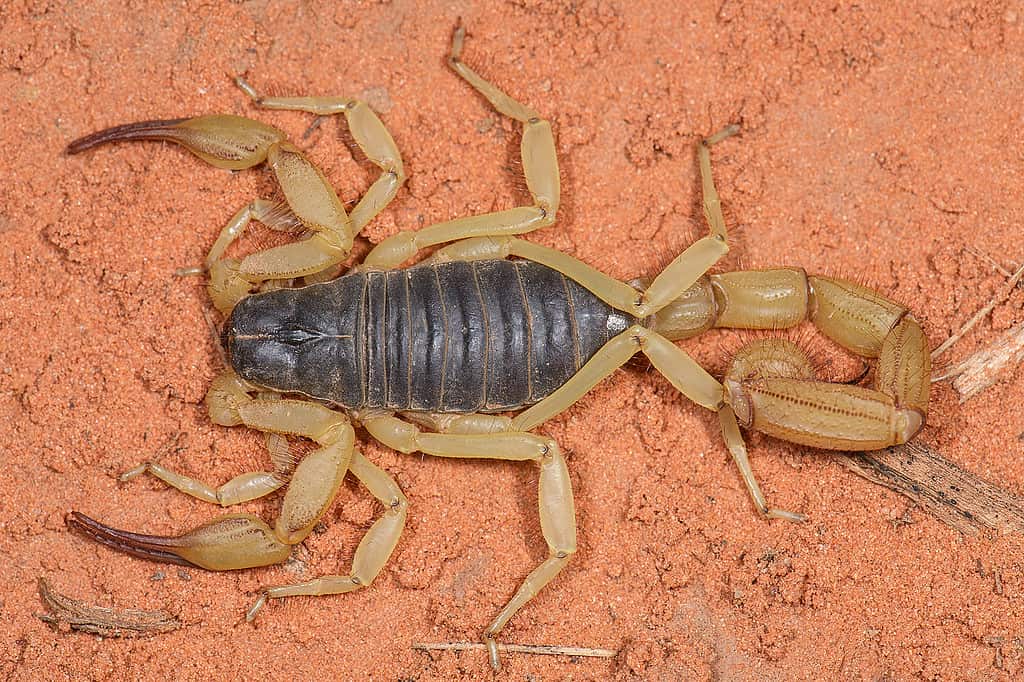
©Marshal Hedin, CC BY 2.0 <https://ift.tt/T5GlvZr>, via Wikimedia Commons – License
10. Sand Scorpion
The sand scorpion (Paruroctonus mesaensis) is a small to medium-sized scorpion species found in California and other parts of the southwestern U.S. and northern Mexico. They can range from 1-2 inches long and are typically light brown or tan.
Sand scorpions have eight legs, two large claws, and a long, segmented tail that ends in a venomous stinger. They have two and several smaller eyes on the top of their cephalothorax. Sand scorpions are one of the smaller scorpion species found in California.
Where Do They Live?
Sand scorpions thrive in arid desert regions like the Mojave and Sonoran deserts.
They’re nocturnal and typically hide under rocks or burrows during the day to avoid the heat. At night, they come out to hunt for small insects and other arthropods.
How Often Do They Sting?
Like most scorpions, sand scorpions generally only sting when threatened or provoked. As a matter of fact, the frequency of stings can vary depending on various factors, such as:
- The environment they live in
- Their population density
- Human activity in their habitat
In general, sand scorpions aren’t aggressive and only sting in self-defense.

©86Eric_Anthony_Mischke 86/Shutterstock.com
The post Scorpions in California: Where They Live and Often They Sting appeared first on AZ Animals.
from Animal News, Facts, Rankings, and More! - AZ Animals https://ift.tt/eJPYQCU